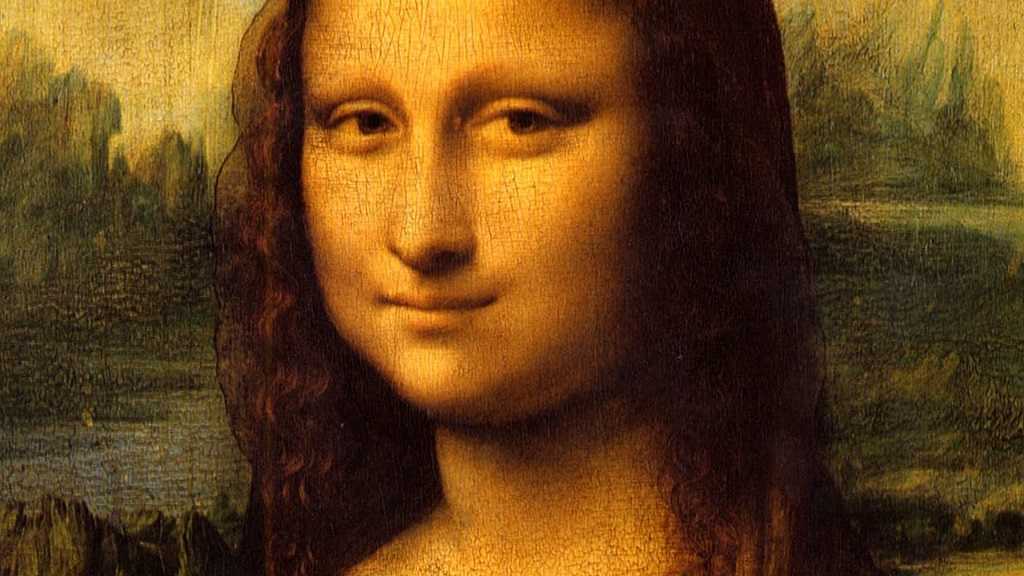Last Updated on 12 March 2024 by TT
Famous Paintings and sculptures in Louvre Museum
Among the thousands of paintings, artpieces and sculptures it is very hard to distinguish the most important paintings and masterpieces in Louvre Museum. In the below list you will find the most famous paintings that we gathered together and also some other masterpieces from different categories. It is recommended to not to leave the museum al least seing the below list, among 450.000 pieces exhibited.
1- Mona Lisa | Leonardo da Vinci
This is the most famous painting in Louvre Musuem and may be even in the world. At the same time “Mona Lisa” is one of the most sensational and popular artworks all around the world. As a result, naturally, this is the most visited painting of Paris. Louvre Museum has a special room dedicated only for Mona Lisa. Mona Lisa which was painted by Leonardo da Vinci in 1503, was acquired by King François I of France in the early 16th century and since then it has been owned by the French State. As many people already know, there are so many mysteries regarding the painting, especially as for the model itself. The most accepted claim about the identity of the model is that it is Lisa Gherardini; the wife of Francesco Bartolomeo de Giocondo who was a silk merchant in Florance.
On August 21, 1911, the Italian carpenter Vincenzo Peruggia took the painting from the museum and stole it. During the absence of the work, the number of visitors to Louvre Museum was lessen but still so many people came to appreciate the space left in the wall. Thus the myth of “La Gioconda” was born. Finally the painting was recovered two years and one hundred eleven days after the robbery.
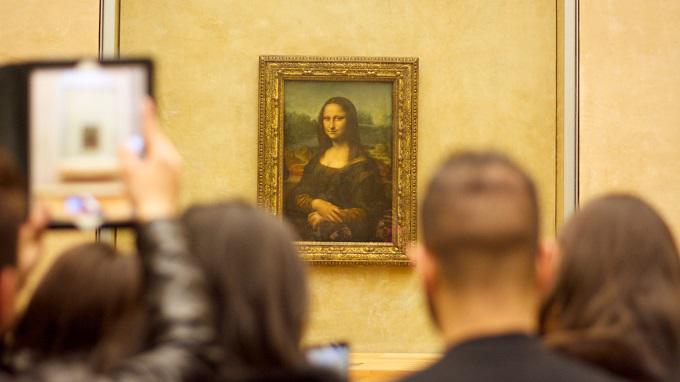
2- The Grand Odalisque by Ingres
(Denon Wing / Room 75)
The French painter Jean Auguste Dominique Ingres was painted this masterpiece with the request of Caroline Bonaparte Murat, the younger sister of Napoleon, in 1814. Her aim was to match Grand Odalisque with another frontal nude painting (which is not exist now) to decorate her Napolitan palace. But the painting never located at this palace since Carolina was overthrown in 1815.
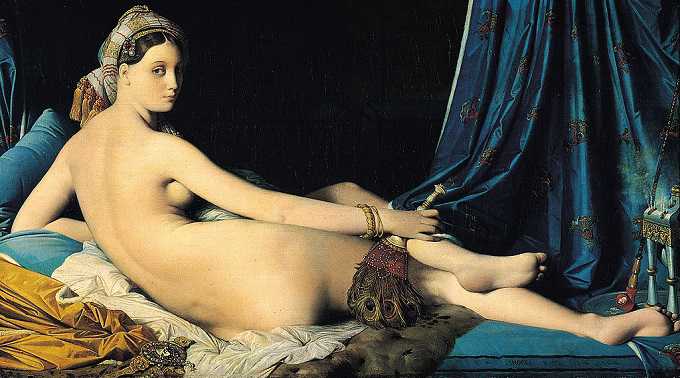
This unique nude figure shows the general interest of exotic and platonic anticipation and romanticism of oriental women in 18th and 19th centuries. We can easily figure out from the accesories and fabrics that the women is representing an Ottoman beauty. The difference between this nude figure and others, this one has a perfect representation of sensuality and pleasure in spite of having anatomic distortions.
3- The Raft Of The Medusa | Théodore Géricault
(Sully Wing / Room 71)
“The Raft of the Medusa” created by the French painter Théodore Géricault between 1818 and 1819, is an icon of French Romanticism and one of the most famous paintings in Louvre Museum. It represents the scene of the wreck of the French Navy frigate “Méduse”, stranded off the coast of Mauritania on July 2, 1816. At least 147 people were adrift on a raft built in haste and all of them except 15 was died during the 13 days before to rescue them. The survivors had to endure hunger, dehydration, cannibalism, and madness.
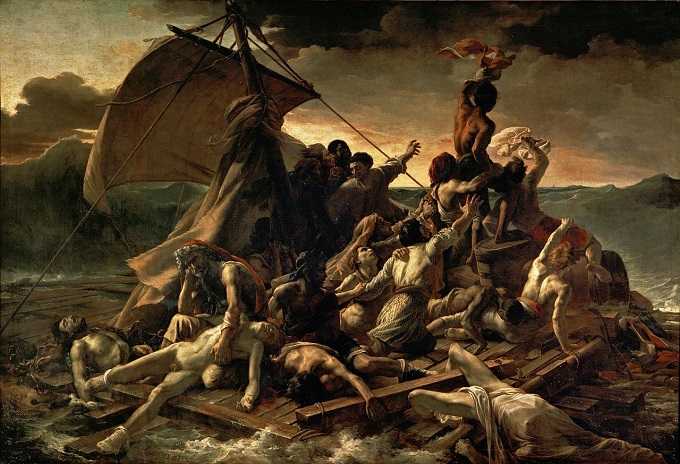
The event became an international scandal, partly because the responsibility were attributed to the incompetence of the French captain who was acting under the authority of the French monarchy. This event and subject fascinated the artist. The painting was very controversial during the exhibition in 1819. The painting was acquired by Louvre Museum shortly after the unexpected death of the artist at his 32.
4- Liberty Leading The People by Delacroix
(DenonWing / Room 77)
This very famous French painting by Eugène Delacroix, depicts a scene from July 28, 1830 in which the people of Paris erected barricades. King Charles X of France had abolished parliament by decree and intended to restrict press freedom. The initial disturbances became an uprising that led to a revolution followed by angry citizens from all walks of life. There was not an only leader. That is why Delacroix represents “freedom” as a guide that leads to the people. Nor is it represented in an abstract form, but is an allegorical figure very sensual and real. The painting was bought by the French State in 1831, but before the criticism received the painting was returned to the painting in 1839. However, in 1848 the Director of the French National Museums claimed that the painting was delivered by the painter the next year. When the Second Empire was established the painting was belong to the Louvre Museum’s collection until it was exposed in 1863, following the death of the painter. By the years, the painting has become a universal icon of the struggle for freedom.
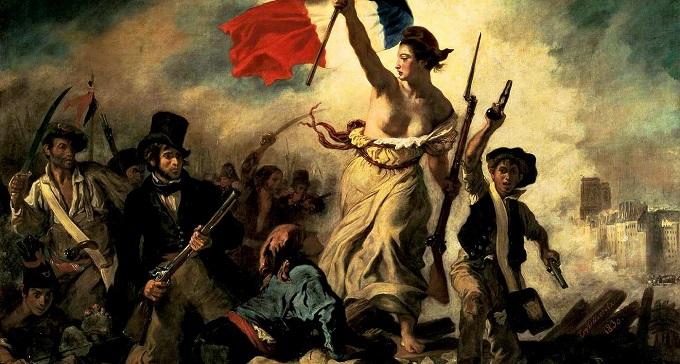
5- The Duchess of Villars (anonymous)
(RicheliousWing / Room 10)
It is estimated that this specular and mysterious painting is painted around 1594 by an unknown artist and belongs to “Second School of Fontainebleau”. On the painting we see two nude women representing Gabrielle d’Estrées (1571- 1599), the lover of King Henry IV and probably one of his sisters. On the other hand, according to some art critics both figure is representing the same women. By pinching of the nipple, the painting may also have an allusion to pregnancy of Estrées who was the mother of Cesar, son of the King Enrique IV. The women knitting a baby dress on the background strengthens this view, as well.
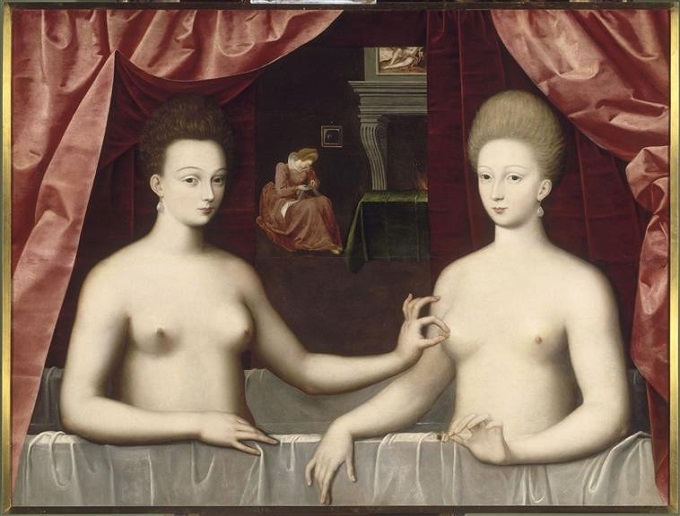
6- The Turkish Bath by Ingres
(SullyWing / Room 60)
(Painted in 1859) Another very famous painting of Dominique Ingres with a repeating theme of orientalist nudes in a Turkish Bath (Hammam). Ingres painted this masterwork after learning the daily life in Istanbul by receiving and reading the letters of Lady Montagu. Montagu was a friend of Ingres and also the wife of English Embassador to Ottoman Empire. As she wrote and described in her letter she had visited one of the Turkish baths in the palace of Constantinople.
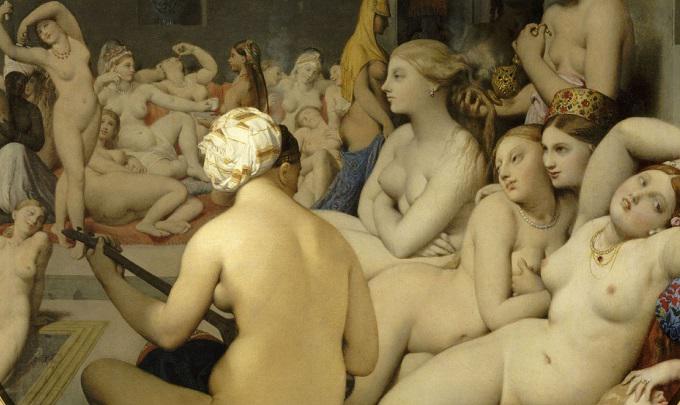
Ingres made this painting in the last years of his life. In the painting we see a group of nude women, playing oud, entertaining and was described in a smooth, erotic and neoclassical style. We can also see a half covered lady and a black lady in the composition.
7- The Marriage Of Cana by Veronese
(Denon Wing / Room 6)
“The Wedding of Cana” is one of the most famous paintings of painter “Veronese”. This oil on canvas was painted in 1563. It is a colossal work and measures 9.94 meters long by 6.77 meters high. He was commissioned on 6th of June 1562 for the refectory of the Benedictine convent of San Giorgio Maggiore in Venice, designed by Palladio. Veronese painted this work in fifteen months.
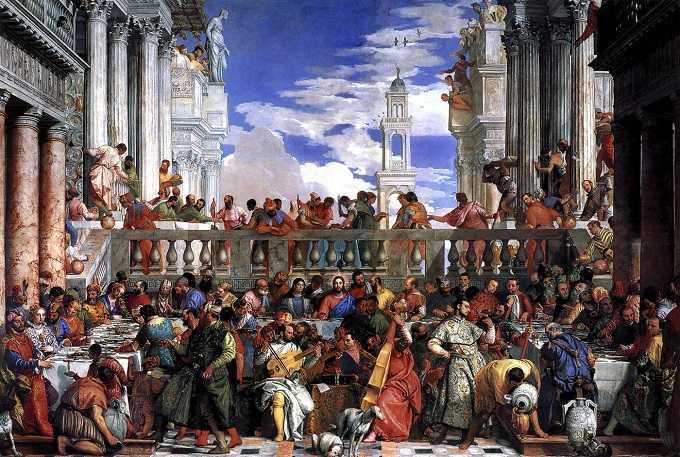
He delivered it to the monastery in September 1563 and it was kept there for 235 years. The painting was stolen by Napoleon during the Italian Campaign in 1797 and sent to Paris. Since then it is in the Louvre Muaeum. Today, it is on the wall opposite of “La Gioconda”. In the original place where was a clone today, made by the company Factum Arte.
8- Baldassare Castiglione by Rafael
(Denon Wing / Room 8)
This portrait was painted by Raphael in 1515. From the Castiglioni house in Mantua, the canvas was transferred to the Netherlands and was purchased in 1630 in Amsterdam by Lucas Van Uffel, Van Dyck’s friend; It is said that Rembrandt went to the auction and tried to bid, but he did not have enough money.
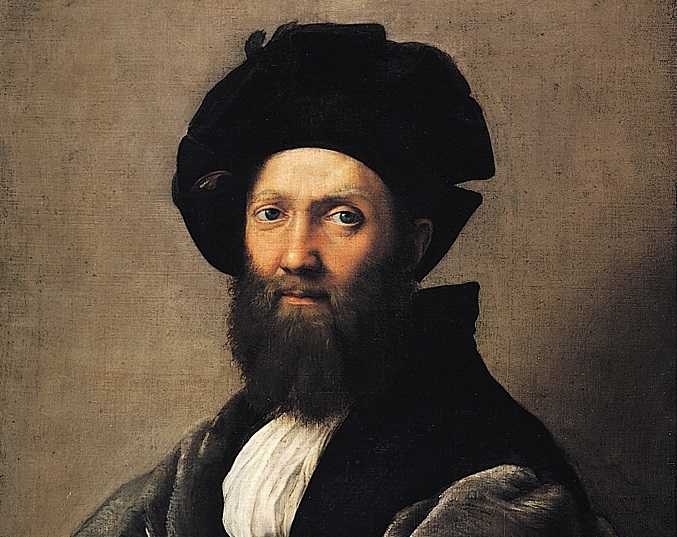
Nine years later the painting was acquired by Cardinal Mazarin and in 1661 entered the collection of Louis XIV of France. Born in Mantua in 1478, Baltasar de Castiglione was an active literary figure in the court of Urbino in the early years of the sixteenth century and he was also an ambassador.
9- Bathsheba In Her Bath by Rembrandt
(Richeliou Wing / Room 32)
“Bathsheba With the Letter of David” or “Bathsheba In Her Bath” is a painting of Rembrandt in 1654, one of the most precious paintings in Louvre Museum. It is signed and dated by the painter himself. The painting represents Bathsheba receiving the letter in which King David invites her to his palace. It is a scene taken from the bible (Second Book of Samuel).
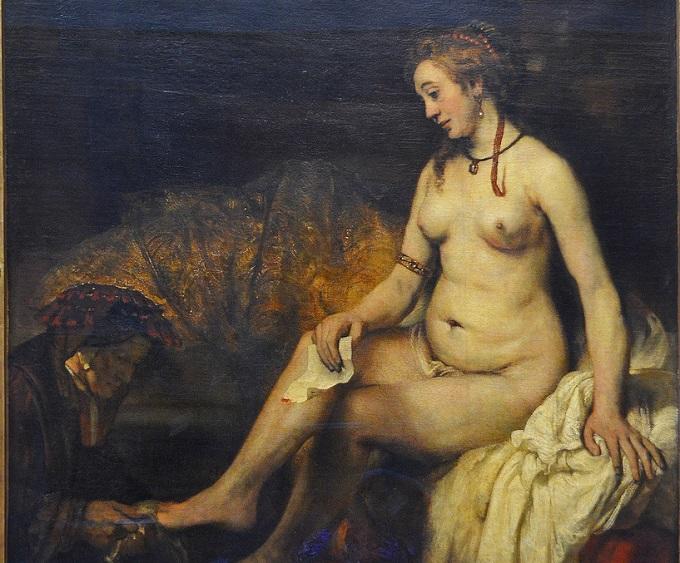
In the painting, which Rembrandt used Hendrickje Stoffels as a model, the impression of his teachers such as Titian and Tintoretto is clearly can be seen. The painting expresses the anguish in the womans face caused by the problems before the Law of Moses, to have to make a decision, either to remain faithful to her husband Uriah, who was in the war, or to obey the king. The painter reflects on the work some symptoms of breast cancer such as tumors in the armpit.
10- The Lacemaker by Vermeer
(Richelieu Wing / Room 38)
“The Lacemaked” by the Dutch painter Johannes Vermeer is one of the most precious paintings in Louvre Museum. Other two very famous paintings of this artist is called “The Milkmaid” in Rijksmuseum / Amsterdam and “The Young Lady Of The Pearl” in Mauritshuis / The Hague. Vermeer is a cult artist, who was created very few works mostly in a period around 1669-1670. It is possible that the first owner of “The Lacemaker” was Pieter Claesz van Ruijven. The painting was appeared in an auction in1696 in Amsterdam. It is later passed to various owners in the Netherlands.
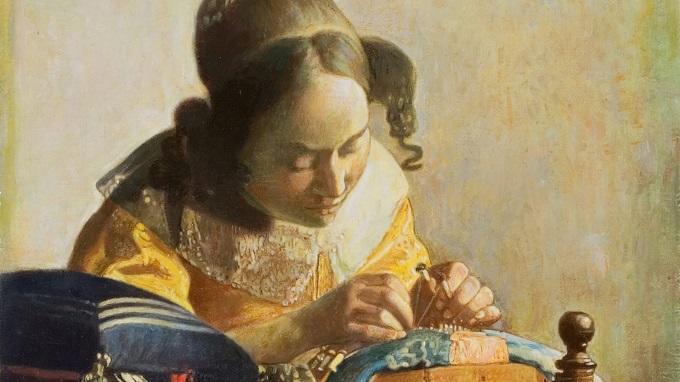
Despite its fame, in 1869 the Boijmans Museum of Rotterdam failed to acquire the painting. At that time it was part of the collection of Dirk Vis Blokhuyzen (1799-1869), who died after leaving his patrimony of paintings, drawings and books to the city of Rotterdam, in return for delivering a sum of money to his heirs. However, this money could not be obtained and the collection was auctioned in Paris in 1870. It was owned by the collector Eugène Féral, who later sold it with a profit of almost 2,000 francs to the Louvre Museum. This was the first Vermeer painting acquired by a French public collection.
Other Famous Paintings in Louvre Museum
- Venus And Three Beauties / Boticelli (Denon Wing / Room 1)
- The Coronation of Napoleon – Jacques-Louis David (Denon Wing / Room 75)
- The Coronation Of Mary / Fra Angelico (Denon Wing / Room 3)
- The Cheat with the Ace of Diamonds / Georges de la Tour (Sully Wing / Room 24)
- Nymph and Satyr / Jean Antoine Watteau (Sully Wing / Room 36)
- Self Portrait / Albrecht Dürer (Richelieu Wing / Room 8)
- The Death Of Virgin / Michelangelo Merisi da Caravaggio (Denon Wing / Room 8)
- The Bather Of Valpinçon / Jean Auguste Ingres (Sully Wing / Room 60)
- Virgen and Child With Santa Ana / Leonardo da Vinci (Denon Wing / Room 5)
- The Virgen OfChancellor Rolin/ Van Eyck (Richeliou Wing / Room 5)
- Portrait Of Francois I / Titian / Tiziano (Denon Wing / Room 6)
- The Astronomer/ Vermeer (Sully Wing / Room B)
- Death Of Sardanapalus / Eugène Delacroix (Denon Wing / Room 77)
- The Moneylander And His Wife/ Quentin Metsys (Richeliou Wing / Room 7)
- Old Man With A Young Boy /Domenico Ghirlandaio (Denon Wing / Room 5)
Other famous sculptures and masterpieces In Louvre Museum
12- Venus de Milo (anonymous)
(Sully Wing / Room 7)
The Aphrodite of Milos, better known as Venus de Milo, is one of the most representative statues of the Hellenistic period of Greek sculpture, and one of the most famous sculptures of ancient Greece. It was created between the years 130 and 100 A. C., and is believed to represent Aphrodite (called Venus in Roman mythology), goddess of love and beauty. This statue was found in Milo (Cyclades Islands), unearthed by a peasant and sold to France between 1819 and 1820. The sculpture was carved in white marble. Its sculptor is unknown, but it has been suggested that it might be the work of Alexander of Antioch. The sculpture has a characteristic style of the late Hellenistic period.
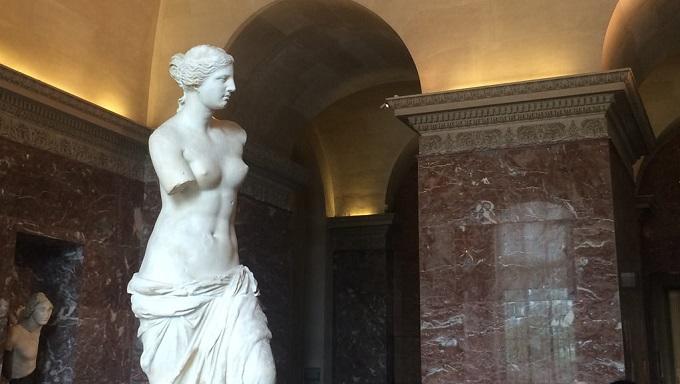
13- Nike of Samothraki (anonymous)
(Escalera / Denon Wing)
If you are enough to see paintings in Louvre Museum you better turn your face some unique sculptures from ancient times. “Victory of Samothrace” represents Nike, the “goddess of victory”. It has a height of 2.45 meters and was made in marble around 190 A.C. It comes from the sanctuary of Cabiros in Samothrace. Some experts attribute it with some probability to Pithókritos of Rhodes.
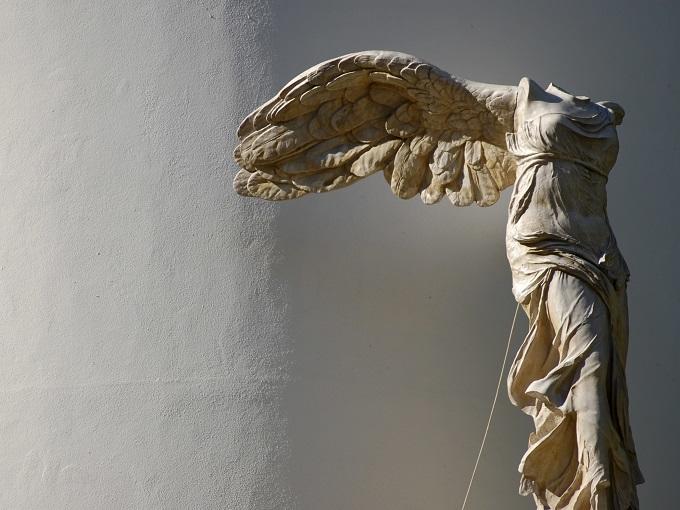
It was discovered in 1863 on the island of Samothrace by the French consul Charles Champoiseau, amateur archaeologist. The female figure of the Winged Victory perches on the bow of a ship, which acts as a pedestal of the female figure. It has been recently restored. Marinetti, in the futuristic manifesto, used this work to condense his attack on the statuary: “A racing car is more beautiful than the Victoria of Samothrace.”
16- The Seating Scribe (anonymous)
Antique Egyption Section (Sully Wing)
Apart from the paintings in Louvre Museum you can see numerious valuable artifacts from Ancient Egypt. “The Seated Scribe” is one of the most representative statues of the sculpture of the Ancient Egyptian Empire, one of the most famous and well preserved of all Egyptian civilization. It was sculpted between the years 2480 and 2350 a. C. In ancient Egypt, the scribes, indispensable in the strongly centralized state, were frequently painted and sculpted.
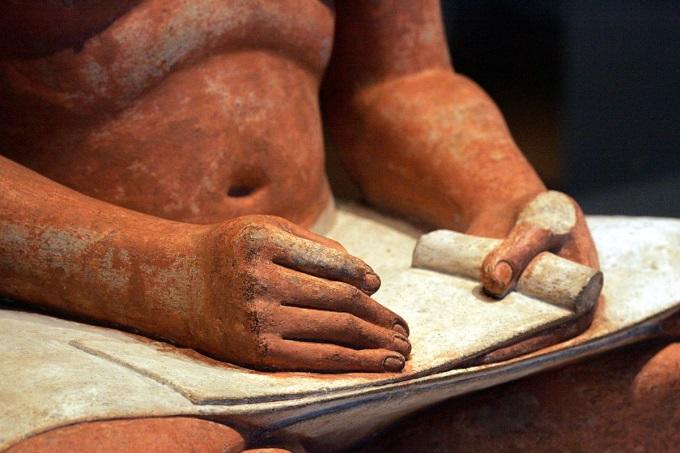
The statue was found in the necropolis of Saqqara, located on the western bank of the Nile, opposite the ancient city of Memphis, which was the capital of the Ancient Egyptian Empire, and is estimated to represent a senior administration official. Placed in the chapel of cult of a tomb, the statue participated in the ceremonies and received the offerings for the deceased, its function had therefore a funerary character. The artist represented him while writing in a seated position with his legs crossed and on top of them rests a papyrus unfolded. The body of the figure is carved with limestone, and his eyes are made of rock crystal, white quartz and ebony.
Other Important Artifacts worth to see in Louvre Museum
14- Psyche Revived by the Kiss of Cupid
(Denon Wing / Room 4)
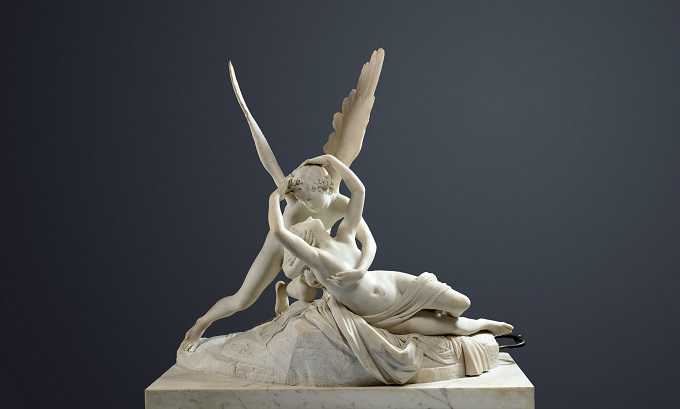
15- The Dying Slave by Michelangelo
(Denon Wing / Room 4)
17- The Assyrian Winged Bulls (Mesopotamia)
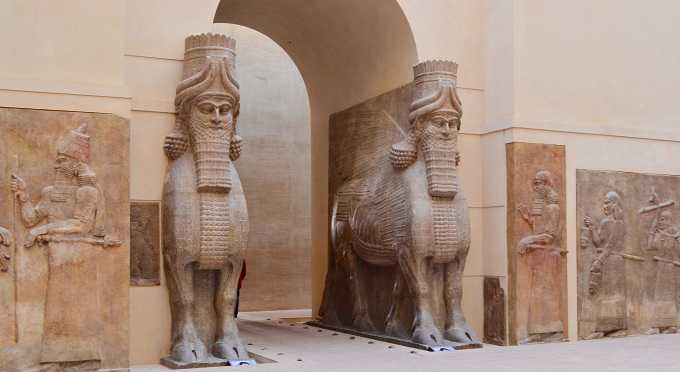
18- Sleeping Hermafrodite
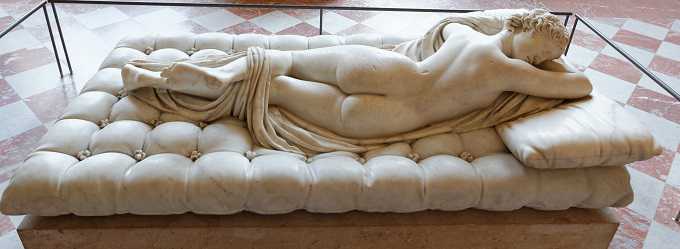
- Apartments of Napoleon III (Ala Richielu / Sala 83-89)
- Chapel of the Tomb of Akhethetep (Ala Sully / Sección Antigüedades Egipcias / Sala 4, 83-89)
- Gladiator Of Borghese (Galleria Daru, Sale B)
- Official website of Louvre Museum
- Private tour guide for Louvre Museum and Paris
- Famous and important paintings,sculptures and masterpieces worth to see in Louvre Museum
